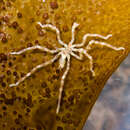mk
имиња во трошки


A. hilgendorfi has 4 pairs of legs. The body consists of 4 somites (segment); the first somite bears a proboscis in anteroventral side which used for ingestion, and compound eyes which have an ocular tube on the dorsal side. The last somite bears an abdomen which has an anal orifice. Ovigers , a pair of appendages on the ventral side are used for cleaning and carrying the egg are found in first somite. (Arnaud and Bamber, 1987)
A. hilgendorfi can be found in many coastal areas including; East Coast Pacific (California, Mexico) (Cole, 1904), Wast Coast Pacific (Japan) (Böhm, 1879) , Mid-Pacific (Society Island and Hawii) (Hilton, 1942; Child, 1970; Muller, 1989), Mediterranean Sea (Lagoon of Venice) (Krapp and Sconfetti ,1983) ,Atlantic (UK) (Bamber, 2012) and North sea (Netherland) (Fassee, 2013). They normally live on sediments, mussel clumps, algae such as kelp, etc. They can also be found on echinoderms (sea cucumber and starfish) (Ohshima,1927; Nakamura & Fujita, 2004) and Hydroid (Hedgpeth, 1940).
Adult A. hilgendorfi display external dimorphism. An example of this is the "Oviger ” which is used for carrying the egg in males. In male A.hilgendorfi , ovigers are larger than in the female. Male A.hilgendorfi usually mate with more than one female and vice versa, which is called polygynandrous (Andersson 1994). The male A.hilgendorfi will carry eggs from many females until they hatch. The eggs will develop to be “ Protonymphon larvae ” which will live separately from their parent. Then, Protonymphon larvae will search for something to hide in immediately such as hydroid , etc. After the 9th moult, they will be an adult (Nakamira, 1981)
A. hilgendorfi can be found in many coastal areas including; East Coast Pacific (California, Mexico) (Cole, 1904), Wast Coast Pacific (Japan) (Böhm, 1879) , Mid-Pacific (Society Island and Hawii) (Hilton, 1942; Child, 1970; Muller, 1989), Mediterranean Sea (Lagoon of Venice) (Krapp and Sconfetti ,1983) ,Atlantic (UK) (Bamber, 2012) and North sea (Netherland) (Fassee, 2013). They normally live on sediments, mussel clumps, algae such as kelp, etc. They can also be found on echinoderms (sea cucumber and starfish) (Ohshima,1927; Nakamura & Fujita, 2004) and Hydroid (Hedgpeth, 1940).
A. hilgendorfi has 4 pairs of legs. The body consists of 4 somites (segment); the first somite bears a proboscis in anteroventral side which used for ingestion, and compound eyes which have an ocular tube on the dorsal side. The last somite bears an abdomen which has an anal orifice. Ovigers , a pair of appendages on the ventral side are used for cleaning and carrying the egg are found in first somite. (Arnaud and Bamber, 1987)
Adult A. hilgendorfi display external dimorphism. An example of this is the "Oviger ” which is used for carrying the egg in males. In male A.hilgendorfi , ovigers are larger than in the female. Male A.hilgendorfi usually mate with more than one female and vice versa, which is called polygynandrous (Andersson 1994). The male A.hilgendorfi will carry eggs from many females until they hatch. The eggs will develop to be “ Protonymphon larvae ” which will live separately from their parent. Then, Protonymphon larvae will search for something to hide in immediately such as hydroid , etc. After the 9th moult, they will be an adult (Nakamira, 1981)
Ammothea hilgendorfi is een zeespin uit de familie Ammotheidae. De soort behoort tot het geslacht Ammothea. Ammothea hilgendorfi werd in 1879 voor het eerst wetenschappelijk beschreven door Böhm. De soort is in de volksmond beter gekend als de zebrazeespin.
In november 2013 werd de zeespin aangetroffen in de Oosterschelde, terwijl deze oorspronkelijk uit de Grote Oceaan komt. Ammothea hilgendorfi lijkt het goed te doen in het Nederlandse water, er werden meerdere exemplaren aangetroffen.
Bronnen, noten en/of referentiesAmmothea hilgendorfi là một loài nhện biển trong họ Ammotheidae. Loài này thuộc chi Ammothea. Ammothea hilgendorfi được miêu tả khoa học năm 1879 bởi Böhm.
Ammothea hilgendorfi là một loài nhện biển trong họ Ammotheidae. Loài này thuộc chi Ammothea. Ammothea hilgendorfi được miêu tả khoa học năm 1879 bởi Böhm.